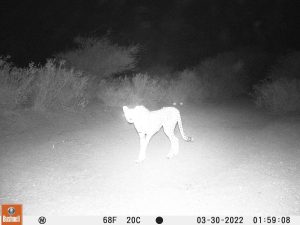
Cheetah. Photo Credit: U.S. Fish and Wildlife Service
Cheetahs, the increasingly rare fleet-footed feline, occupy less than 10% of their native range across most of Africa and, until recently, were believed to be likely gone from the Horn of Africa.
Conservation biologists from Utah unexpectedly recorded images of an adult cheetah while conducting a biodiversity survey last year in the East African nation of Djibouti, according to newly published research. The findings, considered preliminary until additional surveys are completed, suggest certain parts of the tiny nation, which borders Ethiopia and Somalia on Africa’s east coast where the Red Sea meets the Gulf of Aden, could be a promising place for recovering cheetah and other imperiled wildlife.
“Although the species was presumed to possibly still exist, there were no confirmed sightings in the country for more than 30 years,” said Houssein Rayaleh, a researcher representing the Association Djibouti Nature and the Djibouti Ministry of Environment and Sustainable Development.
A persecuted predator
Fewer than 300 adult cheetahs are believed to remain in the wild in East Africa. Illegally trafficking of cubs into the pet trade, deliberate poisoning and habitat fragmentation are the main reasons for the cheetah’s disappearance.

PHOTO CREDIT: HawkWatch International
A map of global cheetah distribution, left, and location of photographic evidence of cheetah on Djibouti’s Digri Plateau in 2022.
The study was led by Megan Murgatroyd of Salt Lake City-based HawkWatch International and featured one-time University of Utah graduate students Evan Buechley, David Blount and Mark Chynoweth.
Two years ago, while he was on HawkWatch’s staff, the World Bank contracted Buechley to organize biodiversity surveys in Djibouti ahead of a development project.
“With my connections with the University of Utah and others, we established a team to do different components and we surveyed bird and mammals and also plants,” said Buechley, an ornithologist expert in vultures. Now a professor at Utah State University, Chynoweth oversaw the mammal portion of the surveys and Buechley the bird portion.
For the project, the team set up camera traps at various locations spread along a 180-kilometer transect running east to west.
“This is really the first large biodiversity assessment ever done in Djibouti,” said Buechley, who now works for the Peregrine Fund as vice president of conservation for international programs. “It’s a very little study country. There have been site-specific or species-specific studies, but we were doing a biodiversity assessment in a transect that ran across the entire country. We didn’t know what to expect.”
Capturing the unexpected with camera traps
Buechley’s us of motion-activated trail cameras have previously led to discoveries that made headlines.
While pursuing his doctorate in 2016, Buechley and a crew of undergrads staked seven calf carcasses to the ground in Utah’s West Desert to observe vultures and other scavengers interact with the carrion. Checking on the site a week later, he discovered one of the carcasses was missing. Or so it seemed.
A review of the images recorded on the camera quickly solved the mystery. Photos showed a badger completely burying the 50-pound carcass over a five-day period, revealing a previously unknown caching behavior. Buechley’s short video of the badger went viral and has been viewed more than a million times.
The Africa research team undertook camera trapping surveys in Djibouti in the fall of 2021 and again in spring of 2022, spanning 42 and 25 days, respectively. They deployed 48 cameras in the first foray and 41 in the second, selecting sites to maximize the chances of wildlife encounters. Cameras were set to shoot bursts of three photographs when triggered by passing animals.
Twenty-seven of the cameras malfunctioned or were stolen or broken, but the group was still able to process more than 1,300 trap nights.
Djibouti’s remote island of biodiversity

PHOTO CREDIT: HawkWatch International
Cheetah photographed on March 30, 2022 on the Digri Plateau of Djibouti, confirming the species presence in the country for the first time in 30 years.
On March 30, at 1:59 a.m., a camera on the rugged and remote Digri Plateau recorded six images of a cheetah of unknown gender. While he found the cheetah discovery exciting, Buechley cautioned against getting too excited.
“They’re not doing good, they’re diminishing, their range is contracting, and you see an individual well outside, well north of its known [occupied] range,” he explained. “That said cheetahs roam very widely. This could just be a lone individual that was on 1,000-kilometer trek across the Horn of Africa, never to be seen in Djibouti again. So there’s that.”
Elsewhere on the Digri Plateau, his team recorded four detections of caracal, a wild cat known for its pointy ears, and two of spotted hyena. The plateau also offered high detection rates for three prey species, dorcas gazelle, gerenuk (a long-necked antelope) and Salt’s dik-dik (a smaller antelope).
“Overall, we recorded the highest mammal species richness and encounter rate on the Digri Plateau relative to the rest of the transect, indicating that the area may have a prey base sufficient to support resident cheetah,” the study stated. “This is the first survey of this type in Djibouti and results should be considered preliminary. Djibouti is a little-studied country, which has high biodiversity. As a rapidly developing country, there are important conservation implications for previously unrecorded species.”
The study appears in the spring edition of Cat News, published by the Species Survival Commission of the International Union for Conservation of Nature.
